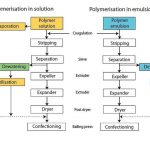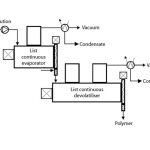For decades, conventional polymerisation has been the norm in the production of elastomers. The time and cost involved in removing and treating solvents in the final stages of production were acceptable. Yet as pressure builds on manufacturers to reduce operating costs, there is greater urgency to develop processes that can help streamline costs and production techniques. One such effort has yielded extremely promising results.
Author Andreas Diener Product Manager, List
Engineers and polymer chemists at List AG have developed an energy-efficient direct devolatilisation technology proven to significantly reduce the costs associated with energy, cooling and water consumption as well as the necessary elastomer processing time and plant footprint. Polymer chemistry opens up opportunities for new elastomer properties and this technology makes it possible to separate new elastomer grades from solvent without any degradation.
Elastomer processing
Solution and emulsion polymerisation are the conventional routes for elastomer synthesis. In the last step of polymer production, the polymer must be separated from the solvent or emulsifying agent. This typically involves several process steps including coagulation, stripping, various mechanical separation stages and drying. Each individual step is energy-intensive and results in large quantities of solvent in the waste stream which need to be incinerated. This requires specialised equipment with considerable facility space in addition to a significant investment (Capex). Direct devolatilisation of elastomers contained in polymer solutions represents a promising alternative solution for reducing the number of polymerisation steps.
Conventional elastomeric polymerisation processes use aliphatic or aromatic hydrocarbons, which must be removed once polymerisation is complete. A water-based coagulant is utilised to separate the elastomers from the solvent by steam stripping; the elastomer is then sepa-rated from the water phase using mechanical and thermal processes.
List’s direct devolatilisation is a completely enclosed, continuous process that directly sepa-rates and simultaneously recovers solvent from the elastomer. As a result, it eliminates all intermediate steps such as water coagulation, steam stripping, mechanical dewatering and drying. Compared to conventional processing, direct devolatilisation yields the same high quality elastomer with all the desired specs – while enabling elastomer producers to reduce energy and water consumption, the plant footprint and the temperature/treatment time ratio. The process involves four steps:
- Pre-concentration removes large amounts of solvent from the polymerisate using thermal energy to increase the efficiency of the overall process.
- Main evaporation removes the solvent and transfers the highly viscous, pre-concentrated elastomer solution. Evaporative cooling keeps the product at the necessary temperature level.
- Final devolatilisation transfers the highly concentrated elastomer to the final expected elastomer quality.
- Confectioning forms the expected product shape to provide a salable product.
Direct devolatilisation can separate 99 % of the solvent and non-converted monomer without any contamination with additional products. Depending on the solvent, the thermal processes can operate at vacuum or slight overpressure. The final elastomer has the same properties as conventional treated products. The Mooney variation is less than ±1 compared to the polymerisate while the residual organic volatile content is less than 100 ppm and the ash content does not increase during the process.
Most elastomers are temperature sensitive, so temperature control is critical to prevent overheating or self-ignition. Direct devolatilisation effectively removes the solvent at temperatures below 100 °C without elastomer degradation. Conventional technology has reached its limits when processing new elastomer grades because of higher adhesiveness. The direct devolatilising process is able to overcome this disadvantage. It allows the development of new, high performance grades which would be impossible, or at best very difficult to process, using conventional technology.
Controlled finishing
The ability to carry out final devolatilisation under carefully controlled conditions is impor-tant in order to obtain the desired elastomer product quality and minimise the risk of overheating or self-ignition. List designed its direct devolatilisation technology to process highly viscous elastomer without overheating or deg-radation, while enabling processors to achieve the expected Mooney viscosity and final volatile content.
During direct devolatilisation, a small amount of water is added to the devolatiliser. As the water bubbles, the organic volatiles get trapped in these bubbles. The organic volatiles are captured and removed by destroying the bubbles. The process can be compared to closed and concentrated stripping in which a small amount of water is used and only 1 % of the total solvent is contaminated. The water/organic volatiles mixture is condensate in a closed system and can be completely recycled. Direct devolatilisation is a completely enclosed process for more than 8000 hours of continuous operation. Self-cleaning metallic surfaces consistently produce high quality product with a low volatile content.
Simple is efficient
Process efficiency is judged by a variety of param-eters including thermal energy and water requirements, the equipment and environmental footprints, the quantity of effluent and the Capex and Opex costs. When measured against these variables, the direct devolatilisation process ranks pretty well. This technology consumes far less energy than conventional processing. The only energy requirements are for evaporating and condensing the solvent. By eliminating the separate processes for coagulation, stripping, mechanical water separation and drying, there is also no longer any need for the mechanical or thermal energy normally associated with these multiple steps.
By achieving 99 % solvent separation without any additional agents, direct devolatilisation prevents the generation of effluent water and eliminates the need for off-gas treatment. The net result is a highly streamlined process that delivers significant energy savings, minimises the environmental impact and reduces operating costs for a higher return on investment.
Scaling up the process
List and Fraunhofer Institute in Schkopau, Germany, worked together to develop the direct devolatilisation process. Research teams followed a step-by-step approach that included initial investigations in the laboratory and then small pilot scale units. The team installed a fully automated mini plant at the List AG headquarters in Arisdorf, Switzerland. This enabled interested and potential users to test direct devolatilisation with their own elastomer solu-tions. Customers were able to run their samples and analyse them for consistency and quality on site.
The process was then scaled up for implementation on a semi-industrial scale at the Pilot Plant Centre for Polymer Synthesis and Processing at the Fraunhofer Gesellschaft, an independent research and development institute in Schkopau, Germany. The Pilot Plant Centre installation allowed engineers to validate the process developed in the R&D lab, verify perfor-mance on a continuous large-scale pilot process and closely evaluate this process during extended periods of operation and with hundreds of tons of elastomer solution. It also provided the team with production samples for application testing, validation of time-intensive processing and product stability by comparing different processing technologies. The technology installed there is designed for continuous and batch operation, with testing capacities ranging from 3 to 50 kg/h of final product.
cpp-net.com/0115417
Share:









